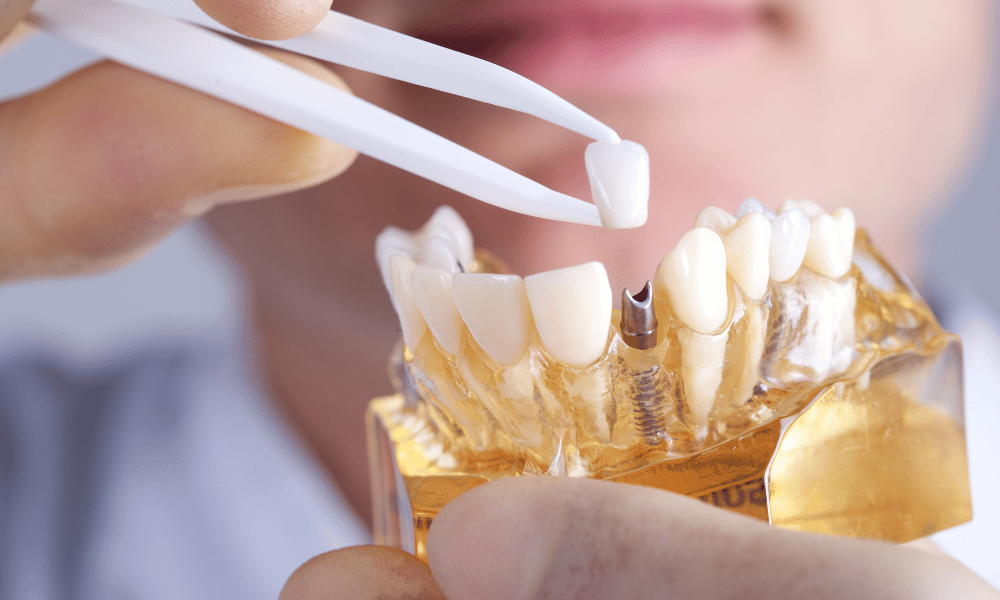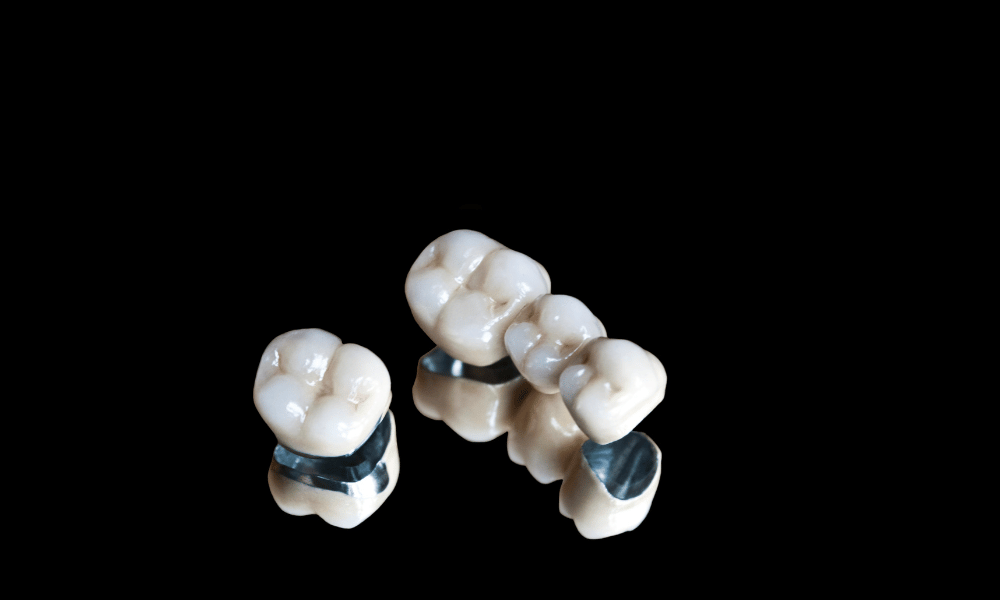February 06, 2025


Written by:
Greg Schubert
Proper tooth restorations should balance increasing the functionality and the appearance of a patient’s damaged or decayed tooth while lasting as long as possible. Two of the most common materials used in tooth restorations are porcelain fused to metals (PFMs) and Zirconia.
Both of these materials restore the capability and appearance of teeth, but they are not entirely the same when compared side by side. Each material can benefit your patients in its own way, so it’s necessary to understand the difference between zirconia and PFM crowns.
So, when comparing zirconia vs. porcelain fused to metal, which does a better job?
PFM restorations have been the preferred option for dental crowns and restorations for over thirty years. These crowns are fabricated using a metal alloy base cemented to the damaged or decayed tooth, with a porcelain exterior placed over the metal. As a result, PFM combines strength and aesthetics in its design.
Dentists have trusted PFM as a reliable option for esthetically pleasing, durable restorations for decades. Various studies have also supported the effectiveness of this common material.
Using PFM has several advantages:
Although PFM restorations look similar to natural teeth, they aren’t perfect. PFM crowns use metal covered by an opaque, naturally colored porcelain cover, so the crown will likely be noticeable compared to the other teeth and not as visually appealing.
Additionally, the metal in the restoration may show over time around the gumline, especially if the gumline begins receding. Metals can also cause allergic reactions in some patients, making PFM less useful for crown work.
PFM has been around for a long time, making it a proven safe and effective option for crowns. This material is also excellent for patients on a budget, saving them money on their restorations. Although PFM is becoming less common in the industry, it still has a strong track record for longevity and effectiveness. With the chance to provide a long-lasting but affordable restoration, it still has its place.
Zirconia is a ceramic, also known as zirconium oxide, that can be placed directly over a worn, damaged, or decayed tooth. This material was introduced as a strong option for dental crowns around 2010 as an alternative to PFM in patients with metal allergies. However, the strength and capability of zirconia quickly made it a standard choice. Although zirconia is newer than PFM, it has become the preferred material amongst dentists.
At PRO-Craft Dental, we have various zirconia products, from Layered Zirconia Dental Crowns to our All-Z™ and ALL Z Plus™ crowns.
Zirconia has quickly become popular in the dental industry since dentists trust it to provide a long-lasting, natural-looking smile.
The advantages of zirconia include:
Zirconia offers many benefits, especially as a newer option that raises the bar for restorations. However, as with anything new, there are still uncertainties. Despite its popularity, zirconia was only introduced about ten years ago, so it has not yet proven itself able to withstand the test of time. Although all signs point to zirconia being the material of the future, some people may have reservations until more studies are conducted to determine whether the material is as long-lasting as it appears.
Zirconia is also more expensive than PFM, ceramic, and other metal crowns, so some patients may opt for a different material.
More dental professionals are using zirconia as a standard for their restorations. The benefits of zirconia are too substantial to overlook, from its impressive strength to its natural appearance. Most importantly, zirconia is also friendlier to the body and has better biocompatibility, as it is less likely to cause an allergic reaction or inflammation when introduced.
Although both of these common restoration materials have advantages and potential drawbacks, the best way to choose between them is through comparison.
Before settling on your final decision, consider the following factors:
| Cost | One of the most significant advantages of PFM is its affordability. Zirconia is more expensive than most other materials that can be used for dental crowns. |
| Strength | In a direct comparison, zirconia is undoubtedly stronger than PFM. The strength of zirconia makes it more capable of lasting through the force of chewing and biting. Although not as strong as zirconia, PFM is still well-known for its durability. |
| Longevity | The superior strength and durability of zirconia bridges suggest positive longevity. However, zirconia restorations may need more time in the industry before determining their longevity. |
| Aesthetics | Porcelain-fused-to-metal (PFM) restorations have been reliable for over 30 years. Still, they may appear less natural over time as the metal becomes visible. Zirconia offers a more lifelike, metal-free appearance, blending with surrounding teeth effortlessly. |
| Biocompatibility | PFM crowns carry a risk of allergic reactions due to their metal content. Zirconia, introduced as a metal-free alternative, eliminates this concern, offering better biocompatibility. |
One of the most significant advantages of PFM vs. zirconia is PFM’s affordability. Zirconia is more expensive than other materials used for dental crowns. However, you get what you pay for, as zirconia crowns cost more for a reason. Zirconia often provides added durability and a more natural look. If a patient is on a budget, PFM is likely the better option.
The price of PFM crowns makes them ideal for budget-conscious patients, especially with their track record of durability and effectiveness. While they may not appear as natural as zirconia, their cost-efficiency is unmatched for those seeking functional and reliable restorations.
When directly comparing PFM vs. zirconia in strength, zirconia is undoubtedly stronger than PFM. Zirconia is up to three times stronger than the porcelain used in PFM crowns, making it more resistant to the forces of chewing and biting. This enhanced durability means zirconia crowns are less likely to chip or crack, providing long-lasting performance.
Additionally, zirconia is gentler on surrounding teeth, minimizing stress and preventing enamel erosion, unlike the rougher porcelain surface in PFM, which can wear down neighboring teeth.
The superior strength and durability of a zirconia bridge vs. PFM suggests positive longevity. Dentists expect that zirconia can last a lifetime. Still, zirconia restorations may need more time in the industry before we can truly determine their longevity.
Although there is plenty of reason to trust zirconia, there haven’t been nearly as many clinical studies on the material simply because it has not been around as long. For those prioritizing proven durability and established results, PFM may be the better choice. However, zirconia's promising durability suggests it could be a strong contender for future longevity.
When comparing esthetics between zirconia vs. PFM, zirconia is the more visually appealing option. Its metal-free composition allows it to blend seamlessly with surrounding teeth, providing a highly lifelike and natural appearance. Unlike PFM, zirconia does not have a metal base, eliminating the risk of visible metal at the gum line even if the gums recede over time.
While PFM crowns, with their porcelain exterior, were initially designed to mimic natural teeth, they may lose their aesthetic appeal over time. For patients wanting a more natural, seamless look, zirconia is the superior choice.
Due to their metal content, PFM crowns can cause allergic reactions vs. zirconia, a metal-free alternative that eliminates this concern with better biocompatibility. Its reduced risk of allergies has made zirconia a preferred choice for modern dental restorations.
Choosing between PFM vs. zirconia is a decision that can’t go wrong. Whether you select PFM or zirconia for your patient’s restoration, they will get a reliable and durable new crown. Still, zirconia restorations are the more modern option and have become the mainstream choice in the industry for a reason.
To learn more about the difference between PFM vs. zirconia, contact PRO-Craft Dental Laboratory today. We are an industry leader in creating digital restorations, meeting our clients’ restorative needs for over 40 years. Don’t make the tough decisions alone. PRO-Craft Dental Laboratory is here to help support your patient however possible.
.png)
Zirconia crowns have quickly become one of the most popular materials for dental restorations. Both patients and providers appreciate zirconia crowns for their durability, strength, translucency and...
Read More.png)
Finding the right material for dental restorations is crucial to meeting your patients’ personalized needs. As a result, providers are constantly deciding which materials will maximize the patient...
Read More
A quality porcelain fused to metal (PFM) crown means nothing if it isn’t prepared properly. PFM crowns have long been some of the most popular options for dental restorations. These crowns provide...
Read More